1993 CHEVROLET BLAZER headlights
[x] Cancel search: headlightsPage 65 of 386

Features & Controls
Locking Rear Axle ........................................................................\
....................... 2-22
Parking Brake
........................................................................\
.............................. 2-23
Parking Over Things That Burn
........................................................................\
. 2-27
Engine Exhaust
........................................................................\
........................... 2-28
Running Your Engine While You’re Parked
...................................................... 2-29
Four-wheel Drive
........................................................................\
........................ 2-30
Transfer Case
........................................................................\
.......................... 2-30
Front Axle Locking Feature
........................................................................\
.... 2-32
Windows
........................................................................\
....................................... 2-33
Horn
........................................................................\
.............................................. 2-35
Tilt Wheel
........................................................................\
..................................... 2-35
Multifunction Lever
........................................................................\
...................... 2-36
Turn Signal and Lane Change Indicator
....................................................... 2-37
Headlight High-Low Beam
........................................................................\
...... 2-38
Windshield Wipers
........................................................................\
................... 2-39
Windshield Washer
........................................................................\
.................. 2-40
Cruise Control
........................................................................\
.......................... 2-41
Headlights and Vehicle Lighting
........................................................................\
. 2-46
Mirrors
........................................................................\
.......................................... 2-51
Sun Visors ........................................................................\
................................... 2-53
Rear Window Wiper and Washer
...................................................................... 2-54
Cigarette LightedAshtrays
........................................................................\
........... 2-55
Storage Compartments ........................................................................\
............... 2-55
Warning Lights, Gages and Indicators
.......................................................... 2-68
Instrument Cluster
........................................................................\
....................... 2-62
Gages
........................................................................\
....................................... 2-76
Luggage Carrier
........................................................................\
........................... 2-80
Trailer Wiring Harness
........................................................................\
................ 2-82
2-2
Page 94 of 386
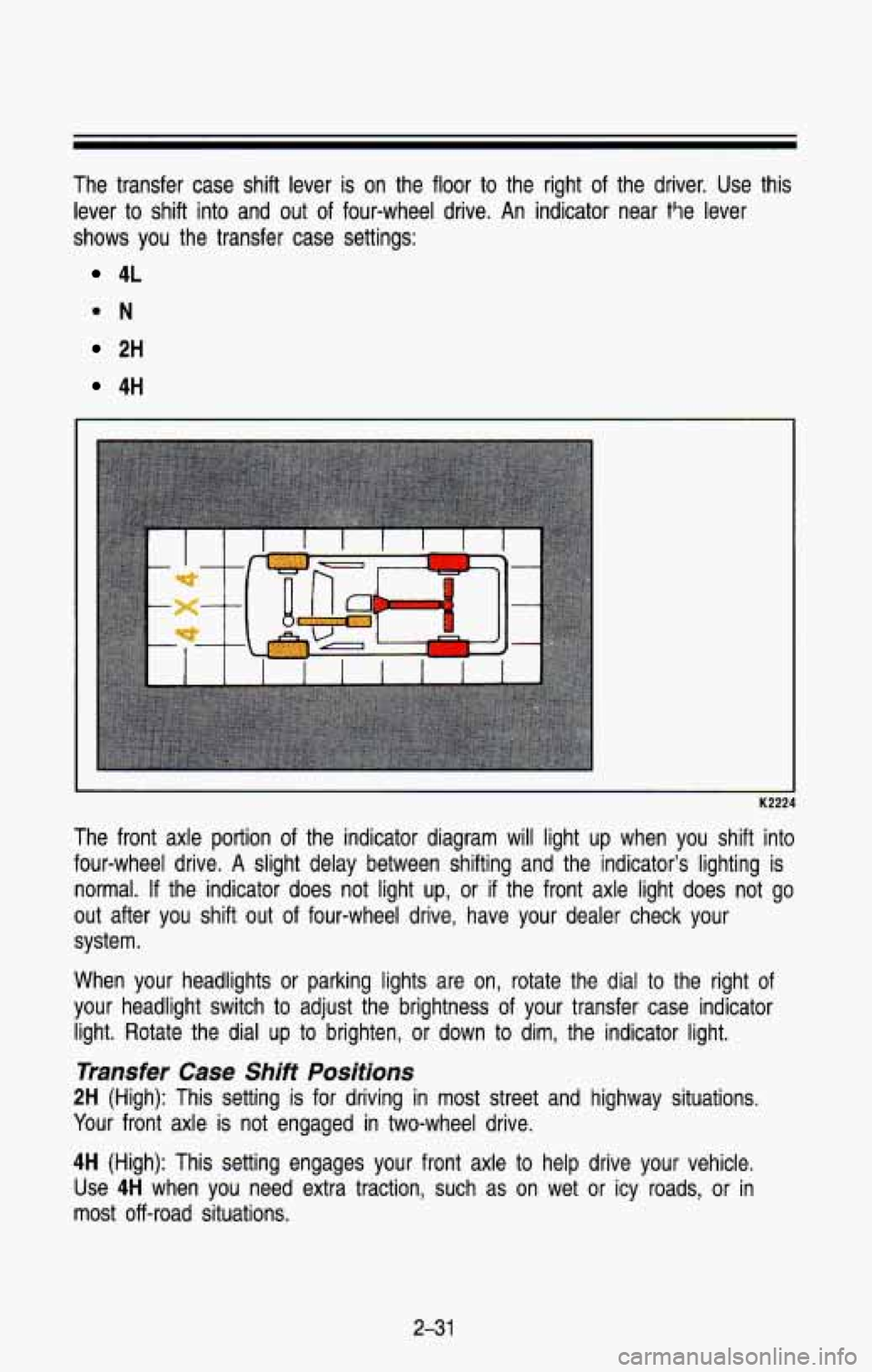
The transfer case shift lever is on the floor to the right of the driver. Use this
lever to shift into and
out of four-wheel drive. An indicator near t9e lever
shows you the transfer case settings:
4L
ON
2H
4H
The front axle portion of the indicator diagram will light up when you shift into
four-wheel drive. A slight delay between shifting and the indic\
ator’s lighting is
normal. If the indicator does not light up, or
if the front axle light does not go
out after you shift
out of four-wheel drive, have your dealer check your
system.
When your headlights or parking lights are
on, rotate the dial to the right of
your headlight switch
to adjust the brightness of your transfer case indicator
light. Rotate the dial up
to brighten, or down to dim, the indicator light.
Transfer Case Shift Positions
2H (High): This setting is for driving in most street and highway situations.
Your front axle
is not engaged in two-wheel drive.
4H (High): This setting engages your front axle to help drive your vehicle.
Use
4H when you need extra traction, such as on wet or icy roads, or in
most
off -road situations.
2-31
Page 100 of 386
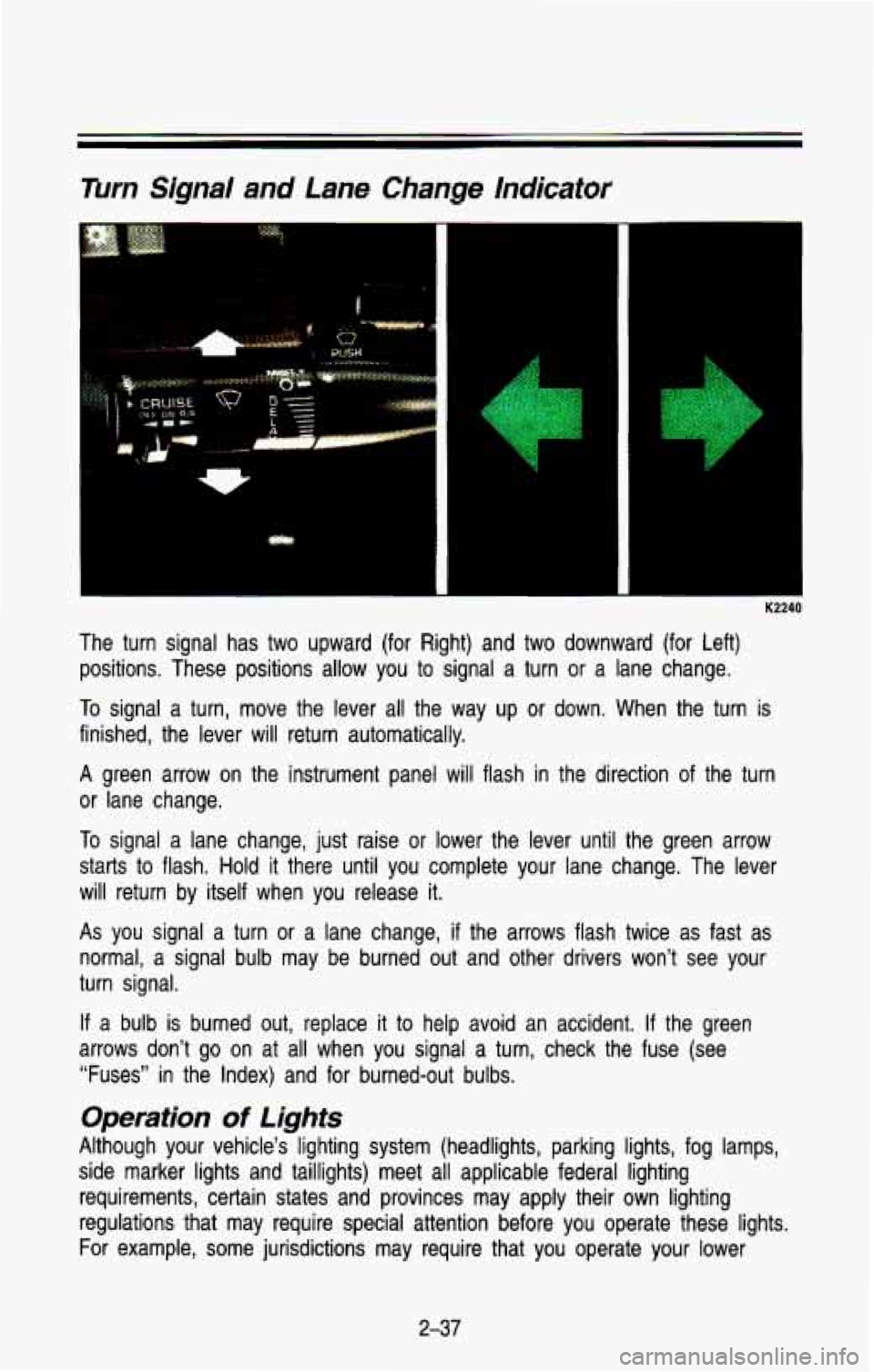
Turn Signal and Lane Change indicator
..
1
." I .. . ..,." .
K2240
The turn signal has two upward (for Right) and two downward \
(for Left) positions. These positions allow you to signal a turn or a lane change.
To signal a turn, move the lever all the way up or down. When the turn is
finished, the lever will return automatically.
A green arrow on the instrument panel will flash in the direction of the turn
or lane change.
To signal a lane change, just raise or lower the lever until the green arrow
starts to flash.
Hold it there until you complete your lane change. The lever
will return by itself when you release it.
As you signal a turn or a lane change, if the arrows flash twice as fast as
normal, a signal bulb may be burned out and other drivers won\
't see your
turn signal.
If a bulb is burned out, replace it to help avoid an accident. If the green
arrows don't go on at all when you signal a turn, check the \
fuse (see
"Fuses" in the Index) and for burned-out bulbs.
Operation of Lights
Although your vehicle's lighting system (headlights, parking lig\
hts, fog lamps,
side marker lights and taillights) meet all applicable federal lighting
requirements, certain states and provinces may apply their own \
lighting
regulations that may require special attention before you operate these lights.
For example, some jurisdictions may require that you operate yo\
ur lower
2-37
Page 101 of 386
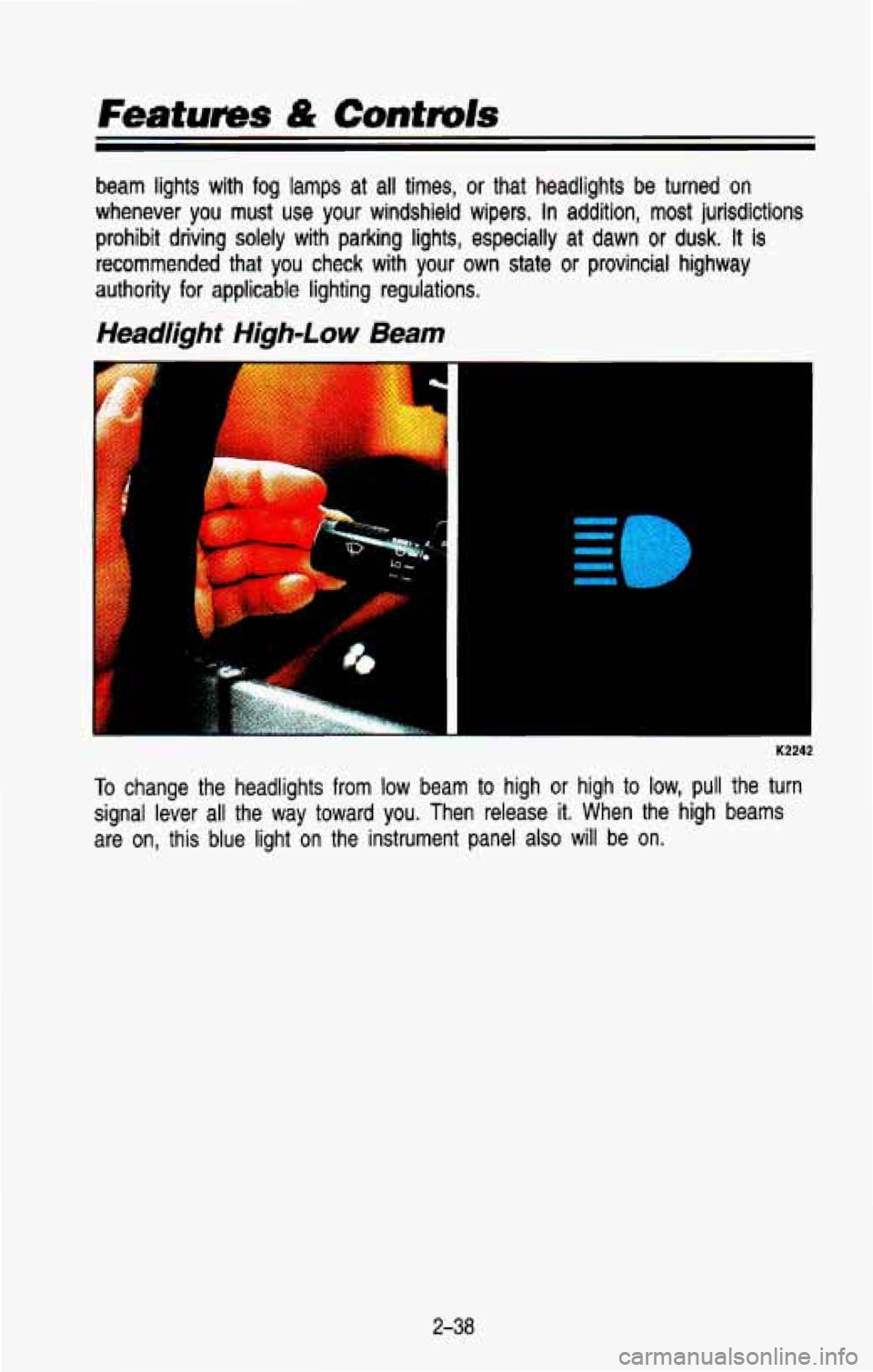
Features & Contmls
beam lights with fog lamps at all times, or that headlights be turned on
whenever you must use your windshield wipers. In addition, most jurisdictions
prohibit driving solely with parking lights, especially
at dawn or dusk. It is
recommended that you check with your own state or provincial h\
ighway
authority for applicable lighting regulations.
Head/ight Hiah-Low Beam
F. p h*' .- ..
K2242
To change the headlights from low beam to high or high to low, pull the turn
signal lever all the way toward you. Then release it. When the high beams
are on, this blue light on the instrument panel
also will be on.
2-38
Page 109 of 386
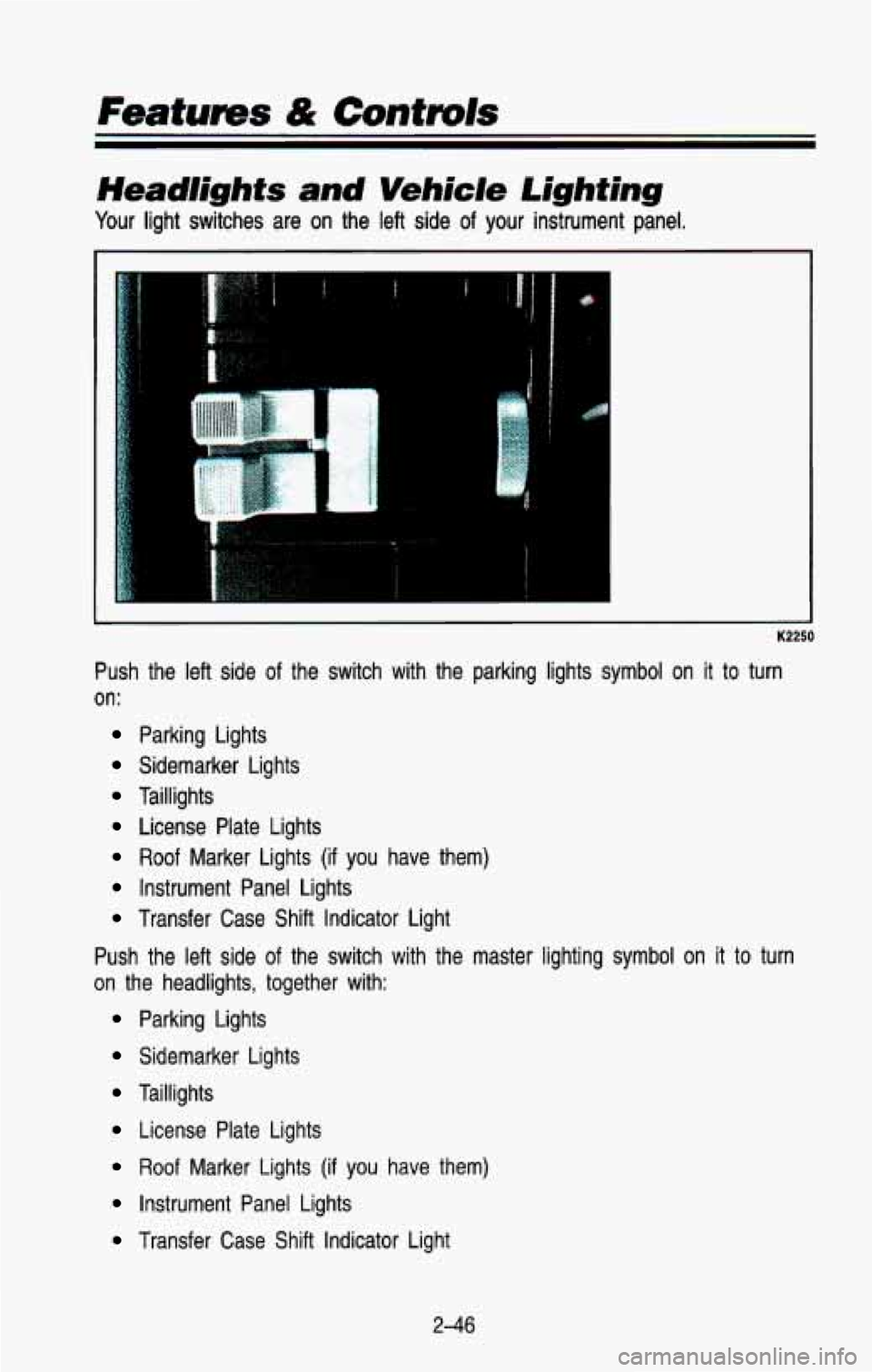
Features & Controls
Headlights and Vehicle Lighting
Your light switches are on the left side of your instrument panel.
!
K2250
Push the left side of the switch with the parking lights symbol on it to turn
on:
Parking Lights
Sidemarker Lights
Taillights
License Plate Lights
Roof Marker Lights (if you have them)
Instrument Panel Lights
Transfer Case Shift Indicator Light
Push the left side of the switch with the master lighting symbol on it
to turn
on the headlights, together with:
Parking Lights
Sidemarker Lights
Taillights
License Plate Lights
Roof Marker Lights (if you have them)
Instrument Panel Lights
Transfer Case Shift Indicator Light
2-46
Page 110 of 386

Push the right side of the switch with the 0 symbol on it to turn off your
lights.
Turn the dial at the right of the headlight switch
to adjust interior lights.
Turning the dial all the way up turns on the interior lights.
You can switch your headlights from low beam
to high by pulling the
multifunction lever toward you.
To return the headlights to low beam, pull the
lever again.
A circuit breaker protects your headlights from electrical overload\
. If you have
an electrical overload, your headlights will flicker on and
off. If this ever
happens, have your headlight wiring checked right away.
Headlights-On Reminder
A buzzer will sound when your headlights are turned on and your ignition is
in
Off, LOCK or Acc.
Daytime Running Lights (DRL) Indicator Light (Canada Only)
K2318
If your vehicle was first sold, when new, in Canada, you will have this light
on the instrument panel.
It goes on whenever the Daytime Running Lights are
on.
Daytime Running Lights (Canada Only)
The Canadian Federal Government has decided that “Daytime Run\
ning
Lights”
(DRL) are a useful feature, in that DRL can make your vehicle more
visible
to pedestrians and other drivers during daylight hours. DRL are
required
on new vehicles sold in Canada.
2-47
Page 111 of 386

Features & Controls
The high beam headlights will come on at reduced brightness in\
Daylight
when:
The ignition is on
The headlight switch is off, and
The parking brake is released
When you turn on your headlights, the DRL will switch
off and the exterior
lights come on. When you turn
off the headlights, the exterior lights will go
out and the high beams
will change to the reduced brightness of DRL again.
The DRL indicator light on the instrument panel will go on wh\
enever the DRL are
on. This light means that only the DRL are on. When you turn on your
exterior lights, this light will go out.
Of course, you may still turn on the
headlights any time you need to.
To idle your vehicle with the DRL
off, set the parking brake. The DRL will
stay off until you release the parking brake.
Dome Lights
The dome lights will come on when you open the doors or tailgate. You can
also turn the dome lights on by turning the interior light dimmer dial on the
headlight switch all the way
up until it clicks.
K2360
You can use the dome lamp switch, located below the headlight swit\
ch, to set
the
dome lamps to come on automatically or remain off. To turn the lights off,
just press the side of the switch marked OFF. To return the lights to
automatic operation, press the side marked
AUTO.
2-48
Page 114 of 386
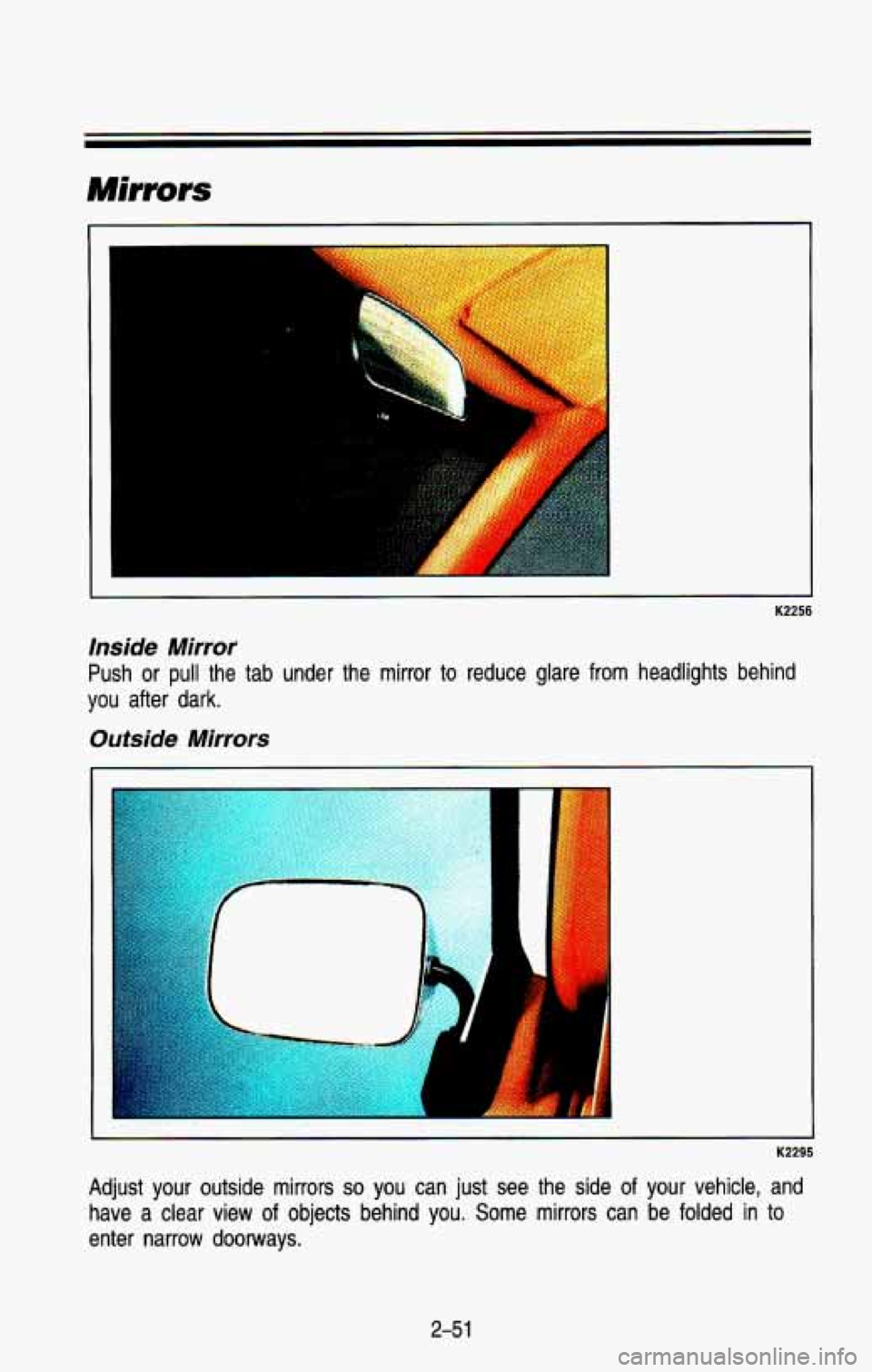
Mirrors
I
K2256
inside Mirror
Push or pull the tab under the mirror to reduce glare from headlights behin\
d
you after dark.
Outside Mirrors
K2295
Adjust your outside mirrors so you can just see the side of your vehicle, and
have a clear view of objects behind you. Some mirrors can
be folded in to
enter narrow doorways.
2-5 1